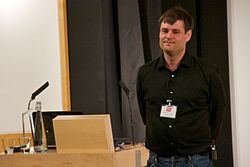Michael Nielsen
Michael Aaron Nielsen | |
|---|---|
 Michael Nielsen talking at Science Online London 2011 | |
| Born | January 4, 1974[citation needed] |
| Nationality | Australian |
| Alma mater | University of New Mexico |
| Awards | Richard C. Tolman Prize Fellow at Caltech, Fulbright Scholar[1] |
| Scientific career | |
| Fields | Physics, Computer science |
| Institutions | Los Alamos National Laboratory Caltech University of Queensland Perimeter Institute Recurse Center |
| Doctoral advisor | Carlton M. Caves[2] |
| Website | http://michaelnielsen.org |
Michael Aaron Nielsen (born January 4, 1974) is a quantum physicist, science writer, and computer programming researcher living in New York City.[3]
In 2004 he was characterized as Australia's "youngest academic" and secured a Federation Fellowship at the University of Queensland; the fellowship was for five years.[4] He worked at the Los Alamos National Laboratory, as the Richard Chace Tolman Prize Fellow at Caltech, and a Senior Faculty Member at the Perimeter Institute for Theoretical Physics. Nielsen obtained his PhD in physics in 1998 at the University of New Mexico.[2] With Isaac Chuang he is the co-author of a popular textbook on quantum computing.[5]
In 2007, Nielsen announced a marked shift in his field of research: from quantum information and computation[5][6] to “the development of new tools for scientific collaboration and publication”.[7] This work includes "massively collaborative mathematics" projects like the Polymath project with Timothy Gowers.[8] Besides writing books and essays, he also gives talks about Open Science.[9]
He is a member of the Working Group on Open Data in Science at the Open Knowledge Foundation.[10]
As of 2015, Nielsen works as a Research Fellow at the Recurse Center.[3][11]
Bibliography
Nielsen, Michael A; Chuang, Isaac L., 1968- (2010), Quantum computation and quantum information (New ed., 10th anniversary ed.), Cambridge University Press, ISBN 978-1-107-00217-3{{citation}}: CS1 maint: multiple names: authors list (link) CS1 maint: numeric names: authors list (link)
His book Reinventing Discovery: The New Era of Networked Science, published by Princeton University Press, was published in 2011.[12] This book is based on themes that are also covered in his essay on the Future of Science.[13]
References
- ^ http://michaelnielsen.org/blog/michael-a-nielsen/ About Michael Nielsen
- ^ a b http://genealogy.math.ndsu.nodak.edu/id.php?id=116803 Nielsen's math genealogy
- ^ a b https://www.recurse.com/blog/93-why-research Recurse Center Blog
- ^ Maiden, Samantha (17 June 2004). "'Footbal star' salaries to boost academic research". The Australian. Canberra, ACT. p. 4. Retrieved 25 April 2013.
- ^ a b Nielsen, Michael A.; Chuang, Isaac L. (2000). Quantum Computation and Quantum Information. Cambridge, UK: Cambridge University Press. ISBN 978-0-521-63235-5. OCLC 43641333.
- ^ Nielsen, M. A. (2004). "The bits that make up the Universe". Nature. 427 (6969): 16–17. doi:10.1038/427016b.
- ^ "Michael Nielsen » Changing fields". Retrieved 2009-01-19.
- ^ Gowers, T.; Nielsen, M. (2009). "Massively collaborative mathematics". Nature. 461 (7266): 879–881. Bibcode:2009Natur.461..879G. doi:10.1038/461879a. PMID 19829354.
- ^ https://www.youtube.com/watch?v=DnWocYKqvhw TEDxWaterloo - Michael Nielsen - Open Science
- ^ "Working Group on Open Data in Science". Retrieved 2009-04-17.
- ^ https://www.recurse.com/blog/83-michael-nielsen-joins-the-recurse-center-to-help-build-a-research-lab Recurse Center Blog
- ^ Nielsen, Michael A. (2011). Reinventing Discovery: The New Era of Networked Science. Princeton, N.J: Princeton University Press. ISBN 0-691-14890-2.
- ^ "Michael Nielsen » The Future of Science". Retrieved 2009-01-19.
